An Evaluation Report: Business Plans of Uber Eats and Alibaba.com
VerifiedAdded on 2023/06/08
|24
|6072
|78
Report
AI Summary
This report provides a detailed analysis of the business plans of Uber Eats and Alibaba. It begins with an executive summary outlining the report's focus on revenue plans, sales channels, and key strengths of each company. The report then delves into the business plans of Uber Eats, examining its revenue sources (customer delivery charges, restaurant partnerships) and its unit economic model. It also explores Alibaba's business plan, highlighting its B2B platform, various sales channels, and financial performance. The report evaluates the strongest and weakest components of each plan, including Uber Eats' market acquisition and Alibaba's value proposition to Chinese customers. Finally, the report offers recommendations for improvement, addressing challenges like unfair contract terms for Uber Eats and government interference for Alibaba, concluding with suggestions to enhance revenue streams and future growth for both companies.
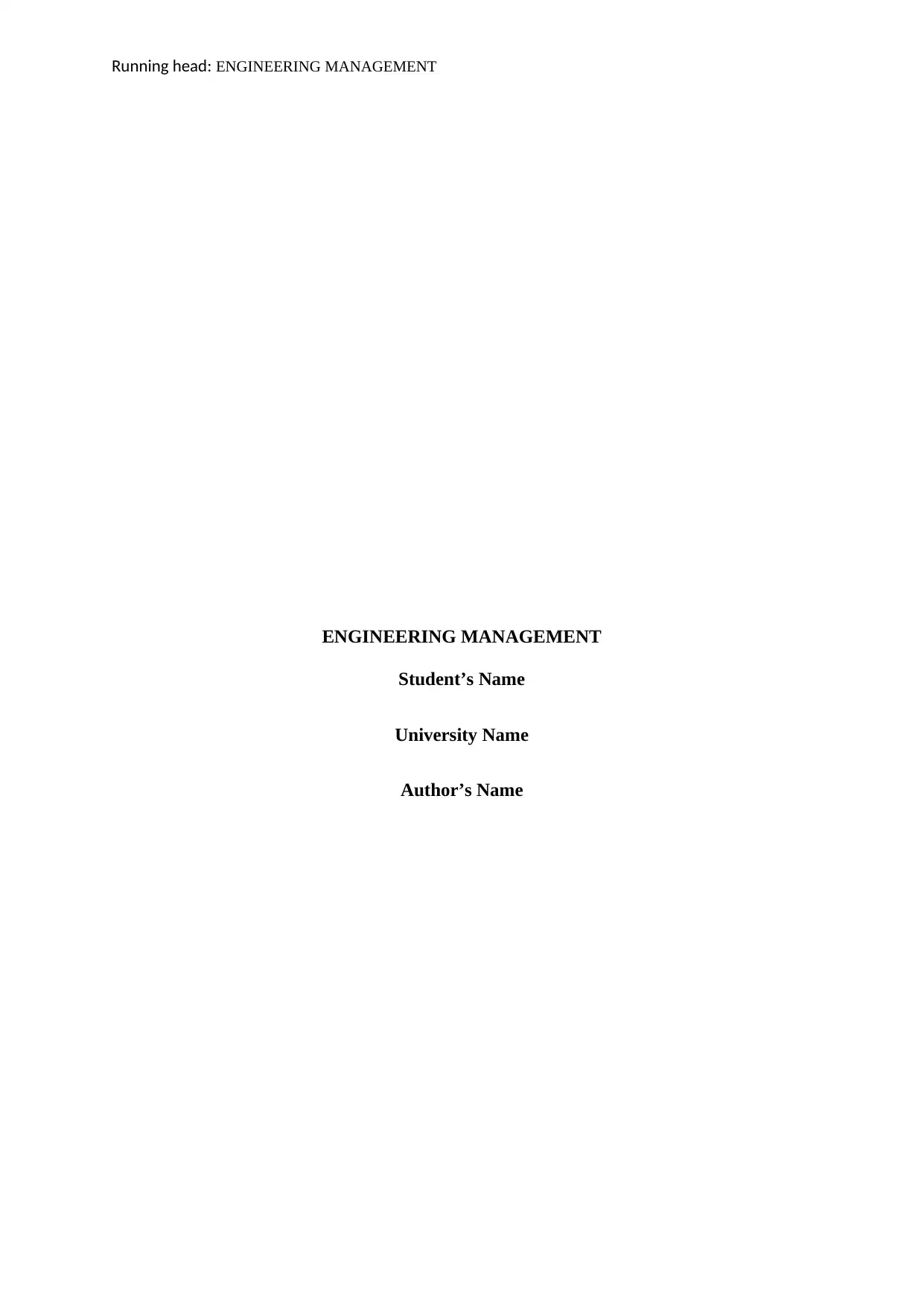
Running head: ENGINEERING MANAGEMENT
ENGINEERING MANAGEMENT
Student’s Name
University Name
Author’s Name
ENGINEERING MANAGEMENT
Student’s Name
University Name
Author’s Name
Paraphrase This Document
Need a fresh take? Get an instant paraphrase of this document with our AI Paraphraser
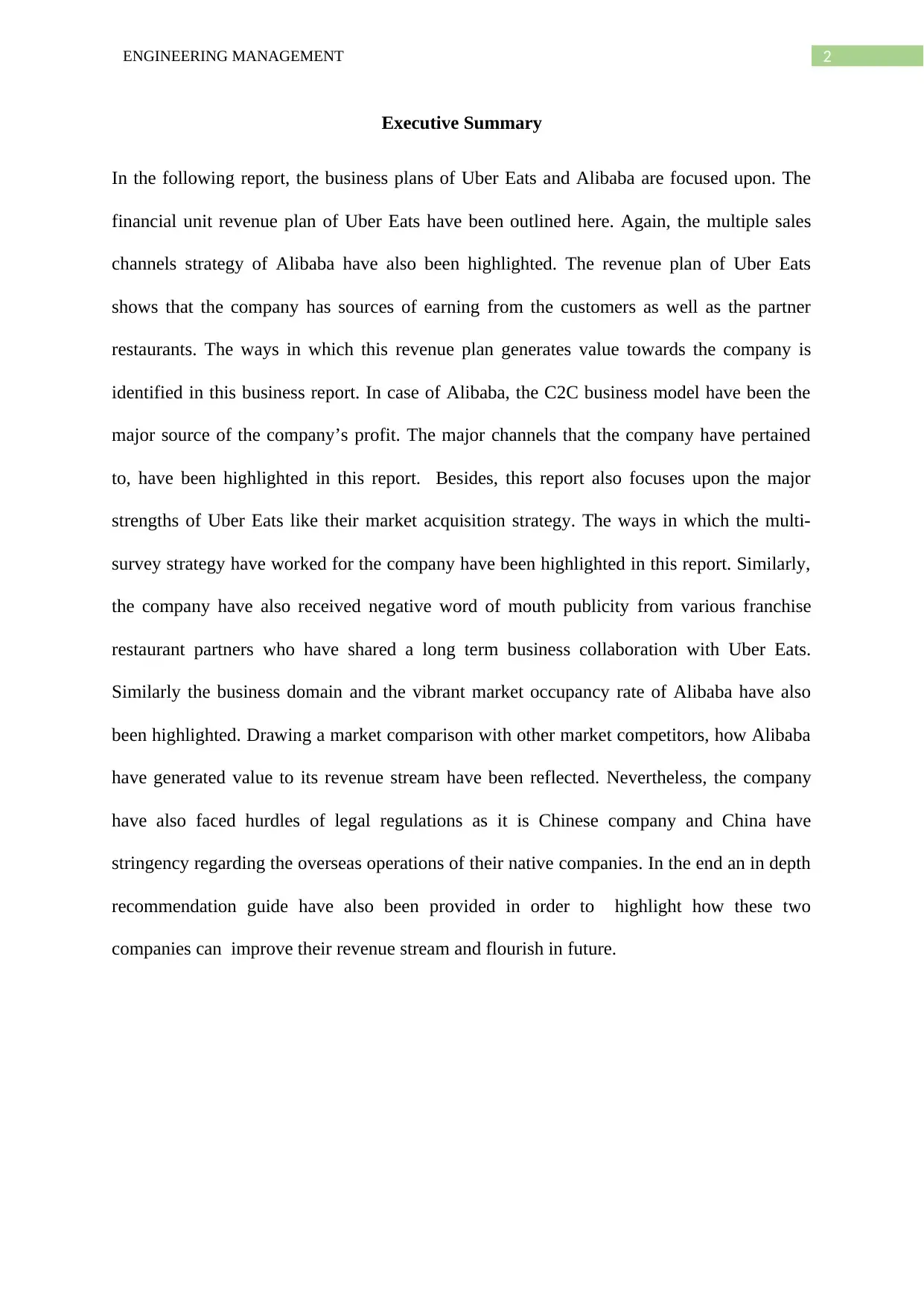
2ENGINEERING MANAGEMENT
Executive Summary
In the following report, the business plans of Uber Eats and Alibaba are focused upon. The
financial unit revenue plan of Uber Eats have been outlined here. Again, the multiple sales
channels strategy of Alibaba have also been highlighted. The revenue plan of Uber Eats
shows that the company has sources of earning from the customers as well as the partner
restaurants. The ways in which this revenue plan generates value towards the company is
identified in this business report. In case of Alibaba, the C2C business model have been the
major source of the company’s profit. The major channels that the company have pertained
to, have been highlighted in this report. Besides, this report also focuses upon the major
strengths of Uber Eats like their market acquisition strategy. The ways in which the multi-
survey strategy have worked for the company have been highlighted in this report. Similarly,
the company have also received negative word of mouth publicity from various franchise
restaurant partners who have shared a long term business collaboration with Uber Eats.
Similarly the business domain and the vibrant market occupancy rate of Alibaba have also
been highlighted. Drawing a market comparison with other market competitors, how Alibaba
have generated value to its revenue stream have been reflected. Nevertheless, the company
have also faced hurdles of legal regulations as it is Chinese company and China have
stringency regarding the overseas operations of their native companies. In the end an in depth
recommendation guide have also been provided in order to highlight how these two
companies can improve their revenue stream and flourish in future.
Executive Summary
In the following report, the business plans of Uber Eats and Alibaba are focused upon. The
financial unit revenue plan of Uber Eats have been outlined here. Again, the multiple sales
channels strategy of Alibaba have also been highlighted. The revenue plan of Uber Eats
shows that the company has sources of earning from the customers as well as the partner
restaurants. The ways in which this revenue plan generates value towards the company is
identified in this business report. In case of Alibaba, the C2C business model have been the
major source of the company’s profit. The major channels that the company have pertained
to, have been highlighted in this report. Besides, this report also focuses upon the major
strengths of Uber Eats like their market acquisition strategy. The ways in which the multi-
survey strategy have worked for the company have been highlighted in this report. Similarly,
the company have also received negative word of mouth publicity from various franchise
restaurant partners who have shared a long term business collaboration with Uber Eats.
Similarly the business domain and the vibrant market occupancy rate of Alibaba have also
been highlighted. Drawing a market comparison with other market competitors, how Alibaba
have generated value to its revenue stream have been reflected. Nevertheless, the company
have also faced hurdles of legal regulations as it is Chinese company and China have
stringency regarding the overseas operations of their native companies. In the end an in depth
recommendation guide have also been provided in order to highlight how these two
companies can improve their revenue stream and flourish in future.
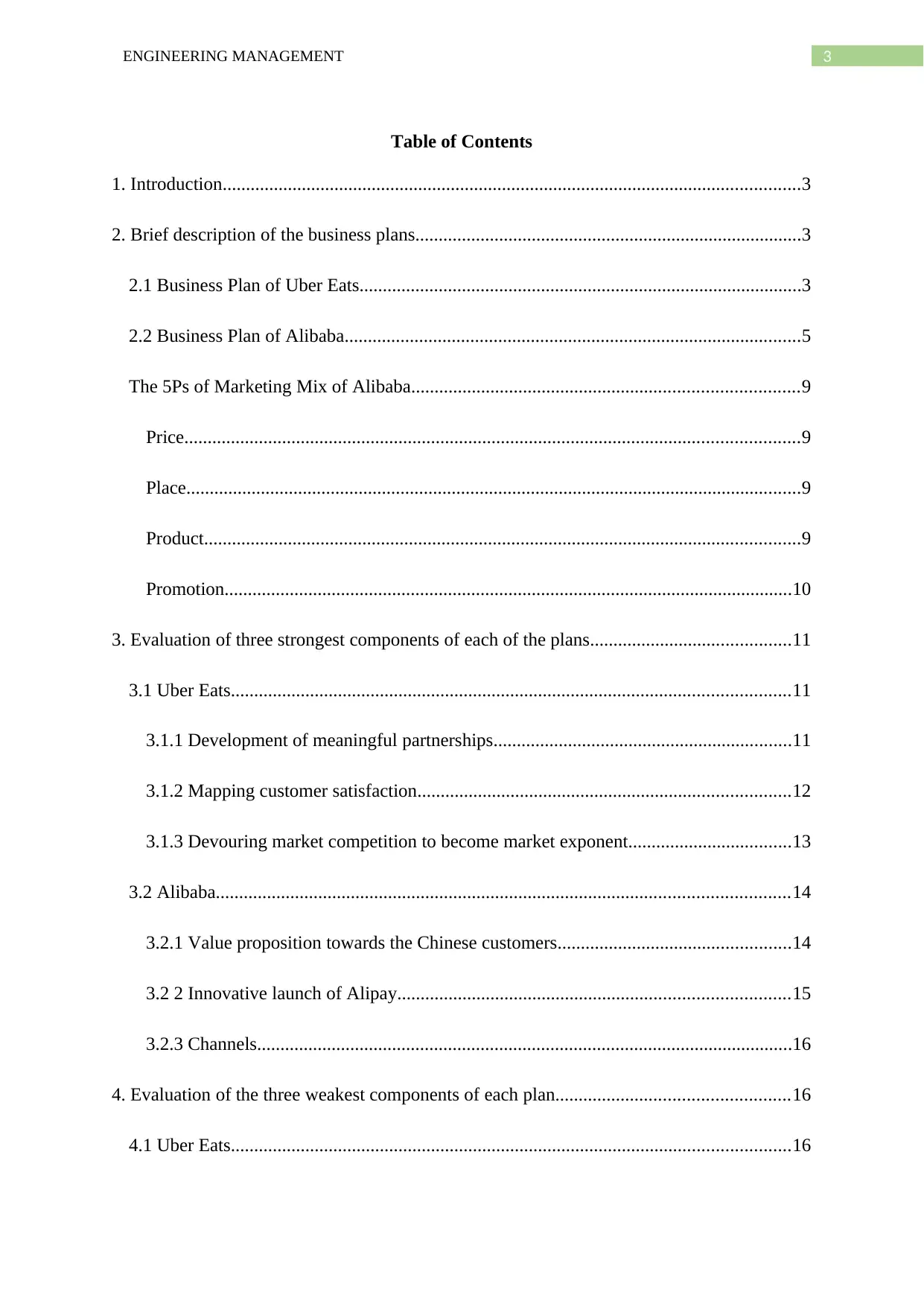
3ENGINEERING MANAGEMENT
Table of Contents
1. Introduction............................................................................................................................3
2. Brief description of the business plans...................................................................................3
2.1 Business Plan of Uber Eats...............................................................................................3
2.2 Business Plan of Alibaba..................................................................................................5
The 5Ps of Marketing Mix of Alibaba...................................................................................9
Price....................................................................................................................................9
Place....................................................................................................................................9
Product................................................................................................................................9
Promotion..........................................................................................................................10
3. Evaluation of three strongest components of each of the plans...........................................11
3.1 Uber Eats........................................................................................................................11
3.1.1 Development of meaningful partnerships................................................................11
3.1.2 Mapping customer satisfaction................................................................................12
3.1.3 Devouring market competition to become market exponent...................................13
3.2 Alibaba...........................................................................................................................14
3.2.1 Value proposition towards the Chinese customers..................................................14
3.2 2 Innovative launch of Alipay....................................................................................15
3.2.3 Channels...................................................................................................................16
4. Evaluation of the three weakest components of each plan..................................................16
4.1 Uber Eats........................................................................................................................16
Table of Contents
1. Introduction............................................................................................................................3
2. Brief description of the business plans...................................................................................3
2.1 Business Plan of Uber Eats...............................................................................................3
2.2 Business Plan of Alibaba..................................................................................................5
The 5Ps of Marketing Mix of Alibaba...................................................................................9
Price....................................................................................................................................9
Place....................................................................................................................................9
Product................................................................................................................................9
Promotion..........................................................................................................................10
3. Evaluation of three strongest components of each of the plans...........................................11
3.1 Uber Eats........................................................................................................................11
3.1.1 Development of meaningful partnerships................................................................11
3.1.2 Mapping customer satisfaction................................................................................12
3.1.3 Devouring market competition to become market exponent...................................13
3.2 Alibaba...........................................................................................................................14
3.2.1 Value proposition towards the Chinese customers..................................................14
3.2 2 Innovative launch of Alipay....................................................................................15
3.2.3 Channels...................................................................................................................16
4. Evaluation of the three weakest components of each plan..................................................16
4.1 Uber Eats........................................................................................................................16
⊘ This is a preview!⊘
Do you want full access?
Subscribe today to unlock all pages.

Trusted by 1+ million students worldwide
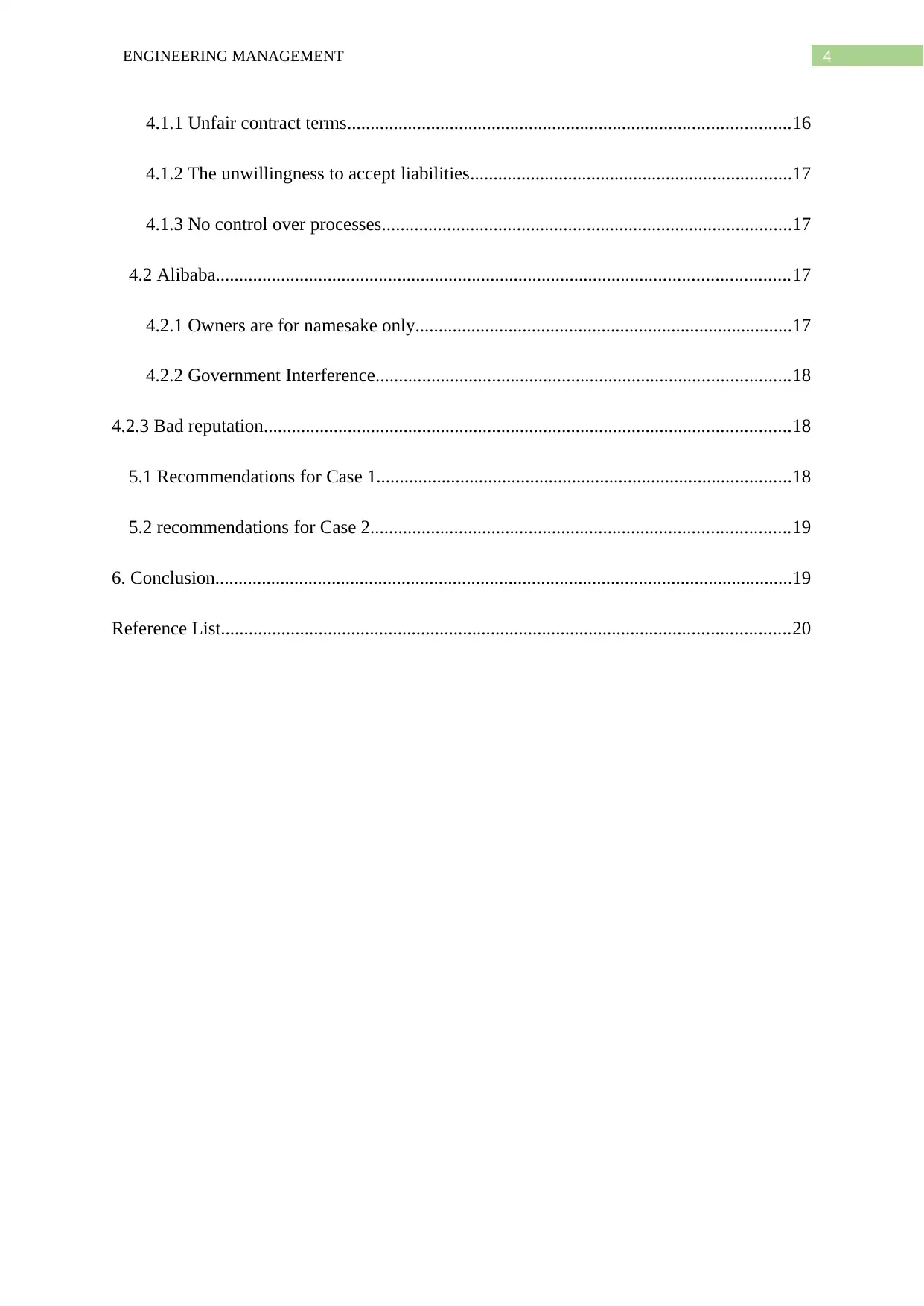
4ENGINEERING MANAGEMENT
4.1.1 Unfair contract terms...............................................................................................16
4.1.2 The unwillingness to accept liabilities.....................................................................17
4.1.3 No control over processes........................................................................................17
4.2 Alibaba...........................................................................................................................17
4.2.1 Owners are for namesake only.................................................................................17
4.2.2 Government Interference.........................................................................................18
4.2.3 Bad reputation.................................................................................................................18
5.1 Recommendations for Case 1.........................................................................................18
5.2 recommendations for Case 2..........................................................................................19
6. Conclusion............................................................................................................................19
Reference List..........................................................................................................................20
4.1.1 Unfair contract terms...............................................................................................16
4.1.2 The unwillingness to accept liabilities.....................................................................17
4.1.3 No control over processes........................................................................................17
4.2 Alibaba...........................................................................................................................17
4.2.1 Owners are for namesake only.................................................................................17
4.2.2 Government Interference.........................................................................................18
4.2.3 Bad reputation.................................................................................................................18
5.1 Recommendations for Case 1.........................................................................................18
5.2 recommendations for Case 2..........................................................................................19
6. Conclusion............................................................................................................................19
Reference List..........................................................................................................................20
Paraphrase This Document
Need a fresh take? Get an instant paraphrase of this document with our AI Paraphraser
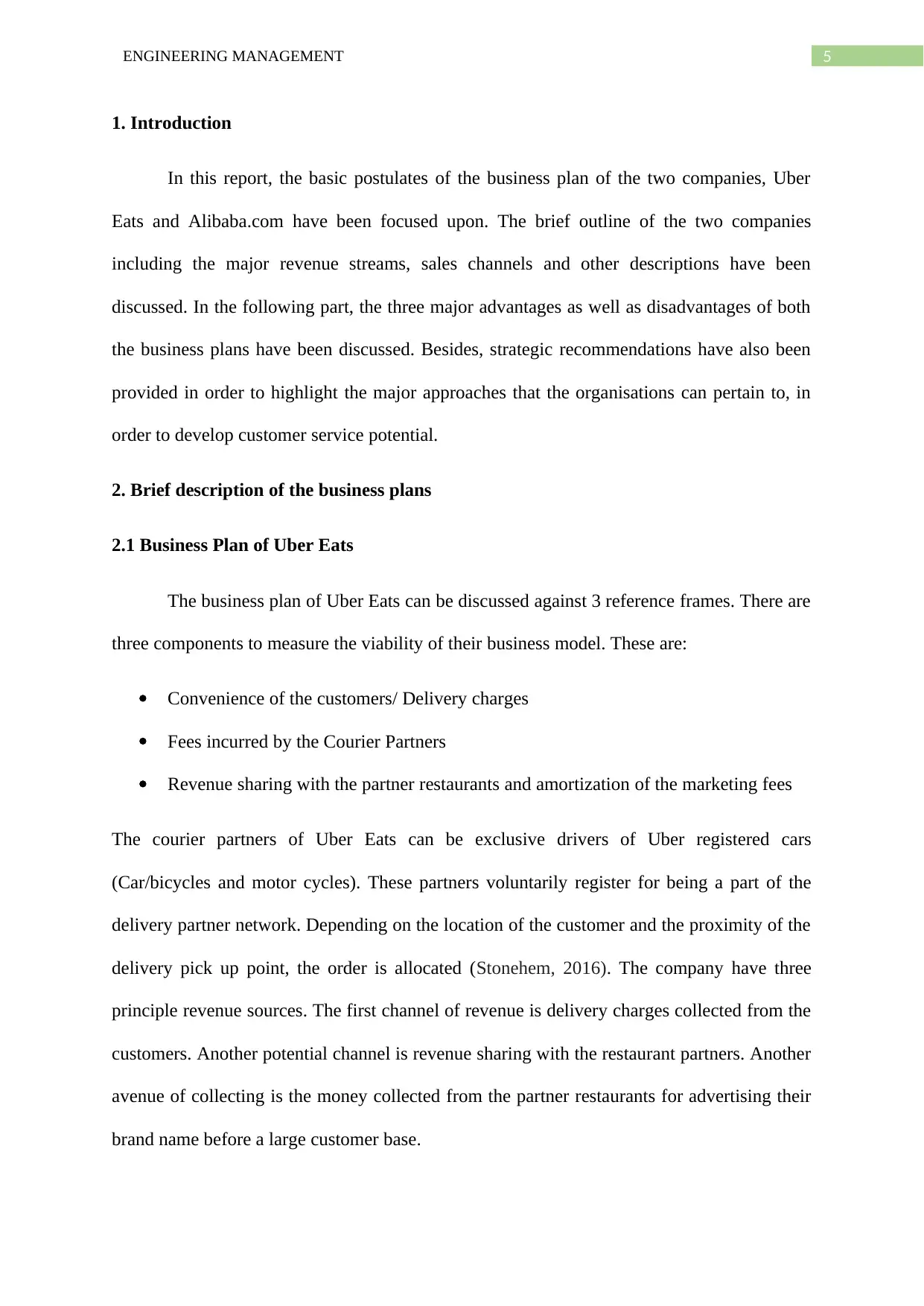
5ENGINEERING MANAGEMENT
1. Introduction
In this report, the basic postulates of the business plan of the two companies, Uber
Eats and Alibaba.com have been focused upon. The brief outline of the two companies
including the major revenue streams, sales channels and other descriptions have been
discussed. In the following part, the three major advantages as well as disadvantages of both
the business plans have been discussed. Besides, strategic recommendations have also been
provided in order to highlight the major approaches that the organisations can pertain to, in
order to develop customer service potential.
2. Brief description of the business plans
2.1 Business Plan of Uber Eats
The business plan of Uber Eats can be discussed against 3 reference frames. There are
three components to measure the viability of their business model. These are:
Convenience of the customers/ Delivery charges
Fees incurred by the Courier Partners
Revenue sharing with the partner restaurants and amortization of the marketing fees
The courier partners of Uber Eats can be exclusive drivers of Uber registered cars
(Car/bicycles and motor cycles). These partners voluntarily register for being a part of the
delivery partner network. Depending on the location of the customer and the proximity of the
delivery pick up point, the order is allocated (Stonehem, 2016). The company have three
principle revenue sources. The first channel of revenue is delivery charges collected from the
customers. Another potential channel is revenue sharing with the restaurant partners. Another
avenue of collecting is the money collected from the partner restaurants for advertising their
brand name before a large customer base.
1. Introduction
In this report, the basic postulates of the business plan of the two companies, Uber
Eats and Alibaba.com have been focused upon. The brief outline of the two companies
including the major revenue streams, sales channels and other descriptions have been
discussed. In the following part, the three major advantages as well as disadvantages of both
the business plans have been discussed. Besides, strategic recommendations have also been
provided in order to highlight the major approaches that the organisations can pertain to, in
order to develop customer service potential.
2. Brief description of the business plans
2.1 Business Plan of Uber Eats
The business plan of Uber Eats can be discussed against 3 reference frames. There are
three components to measure the viability of their business model. These are:
Convenience of the customers/ Delivery charges
Fees incurred by the Courier Partners
Revenue sharing with the partner restaurants and amortization of the marketing fees
The courier partners of Uber Eats can be exclusive drivers of Uber registered cars
(Car/bicycles and motor cycles). These partners voluntarily register for being a part of the
delivery partner network. Depending on the location of the customer and the proximity of the
delivery pick up point, the order is allocated (Stonehem, 2016). The company have three
principle revenue sources. The first channel of revenue is delivery charges collected from the
customers. Another potential channel is revenue sharing with the restaurant partners. Another
avenue of collecting is the money collected from the partner restaurants for advertising their
brand name before a large customer base.
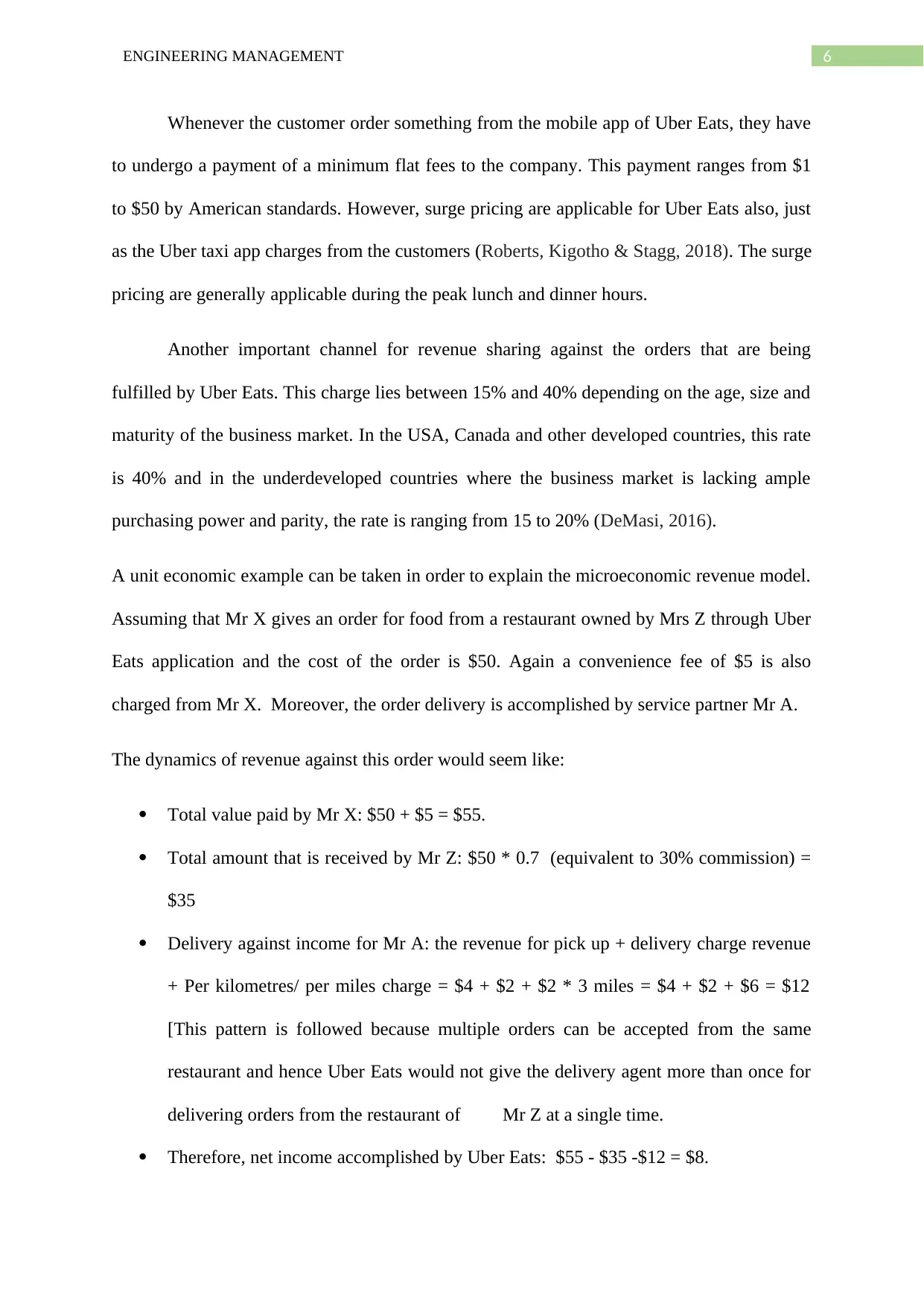
6ENGINEERING MANAGEMENT
Whenever the customer order something from the mobile app of Uber Eats, they have
to undergo a payment of a minimum flat fees to the company. This payment ranges from $1
to $50 by American standards. However, surge pricing are applicable for Uber Eats also, just
as the Uber taxi app charges from the customers (Roberts, Kigotho & Stagg, 2018). The surge
pricing are generally applicable during the peak lunch and dinner hours.
Another important channel for revenue sharing against the orders that are being
fulfilled by Uber Eats. This charge lies between 15% and 40% depending on the age, size and
maturity of the business market. In the USA, Canada and other developed countries, this rate
is 40% and in the underdeveloped countries where the business market is lacking ample
purchasing power and parity, the rate is ranging from 15 to 20% (DeMasi, 2016).
A unit economic example can be taken in order to explain the microeconomic revenue model.
Assuming that Mr X gives an order for food from a restaurant owned by Mrs Z through Uber
Eats application and the cost of the order is $50. Again a convenience fee of $5 is also
charged from Mr X. Moreover, the order delivery is accomplished by service partner Mr A.
The dynamics of revenue against this order would seem like:
Total value paid by Mr X: $50 + $5 = $55.
Total amount that is received by Mr Z: $50 * 0.7 (equivalent to 30% commission) =
$35
Delivery against income for Mr A: the revenue for pick up + delivery charge revenue
+ Per kilometres/ per miles charge = $4 + $2 + $2 * 3 miles = $4 + $2 + $6 = $12
[This pattern is followed because multiple orders can be accepted from the same
restaurant and hence Uber Eats would not give the delivery agent more than once for
delivering orders from the restaurant of Mr Z at a single time.
Therefore, net income accomplished by Uber Eats: $55 - $35 -$12 = $8.
Whenever the customer order something from the mobile app of Uber Eats, they have
to undergo a payment of a minimum flat fees to the company. This payment ranges from $1
to $50 by American standards. However, surge pricing are applicable for Uber Eats also, just
as the Uber taxi app charges from the customers (Roberts, Kigotho & Stagg, 2018). The surge
pricing are generally applicable during the peak lunch and dinner hours.
Another important channel for revenue sharing against the orders that are being
fulfilled by Uber Eats. This charge lies between 15% and 40% depending on the age, size and
maturity of the business market. In the USA, Canada and other developed countries, this rate
is 40% and in the underdeveloped countries where the business market is lacking ample
purchasing power and parity, the rate is ranging from 15 to 20% (DeMasi, 2016).
A unit economic example can be taken in order to explain the microeconomic revenue model.
Assuming that Mr X gives an order for food from a restaurant owned by Mrs Z through Uber
Eats application and the cost of the order is $50. Again a convenience fee of $5 is also
charged from Mr X. Moreover, the order delivery is accomplished by service partner Mr A.
The dynamics of revenue against this order would seem like:
Total value paid by Mr X: $50 + $5 = $55.
Total amount that is received by Mr Z: $50 * 0.7 (equivalent to 30% commission) =
$35
Delivery against income for Mr A: the revenue for pick up + delivery charge revenue
+ Per kilometres/ per miles charge = $4 + $2 + $2 * 3 miles = $4 + $2 + $6 = $12
[This pattern is followed because multiple orders can be accepted from the same
restaurant and hence Uber Eats would not give the delivery agent more than once for
delivering orders from the restaurant of Mr Z at a single time.
Therefore, net income accomplished by Uber Eats: $55 - $35 -$12 = $8.
⊘ This is a preview!⊘
Do you want full access?
Subscribe today to unlock all pages.

Trusted by 1+ million students worldwide
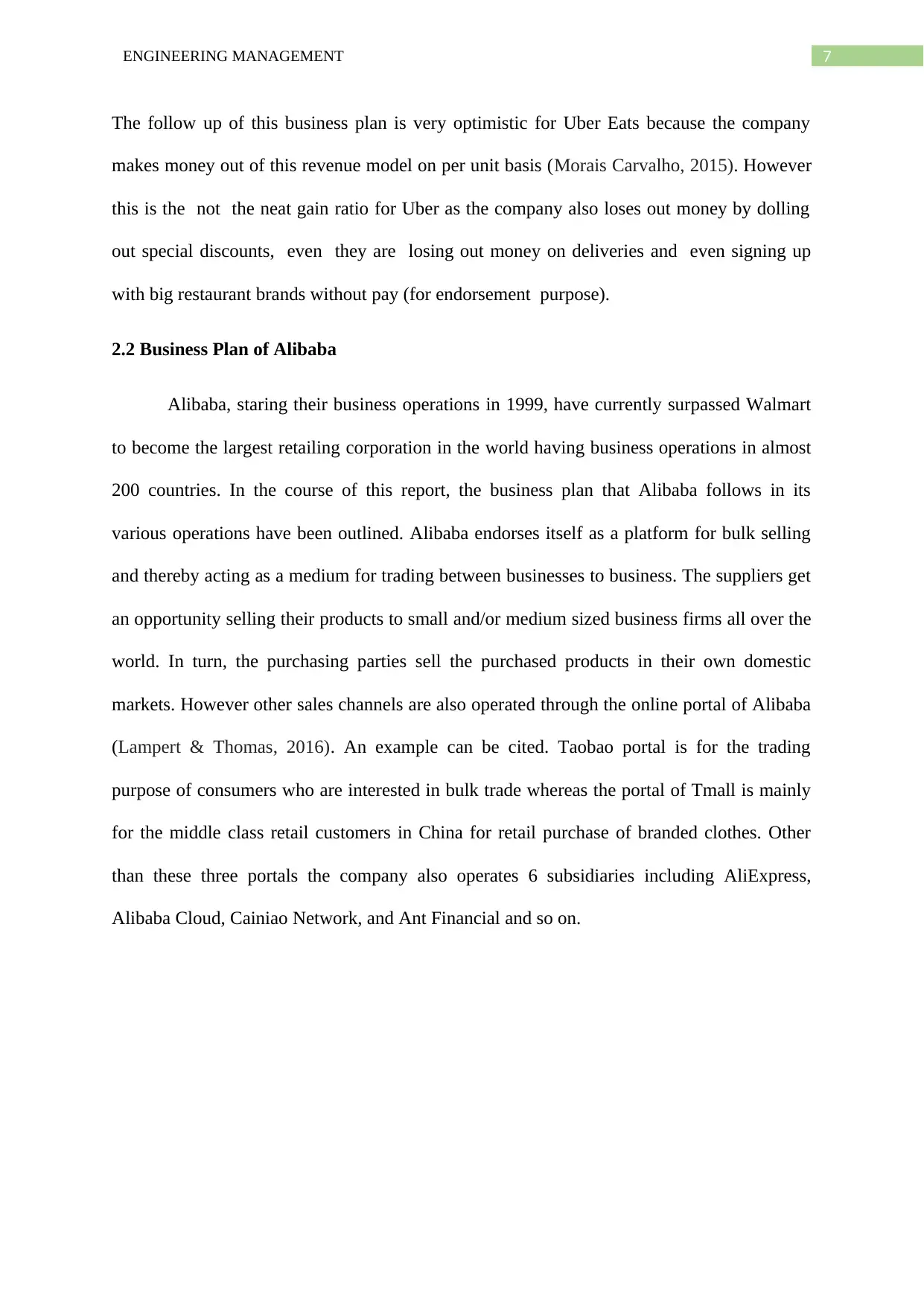
7ENGINEERING MANAGEMENT
The follow up of this business plan is very optimistic for Uber Eats because the company
makes money out of this revenue model on per unit basis (Morais Carvalho, 2015). However
this is the not the neat gain ratio for Uber as the company also loses out money by dolling
out special discounts, even they are losing out money on deliveries and even signing up
with big restaurant brands without pay (for endorsement purpose).
2.2 Business Plan of Alibaba
Alibaba, staring their business operations in 1999, have currently surpassed Walmart
to become the largest retailing corporation in the world having business operations in almost
200 countries. In the course of this report, the business plan that Alibaba follows in its
various operations have been outlined. Alibaba endorses itself as a platform for bulk selling
and thereby acting as a medium for trading between businesses to business. The suppliers get
an opportunity selling their products to small and/or medium sized business firms all over the
world. In turn, the purchasing parties sell the purchased products in their own domestic
markets. However other sales channels are also operated through the online portal of Alibaba
(Lampert & Thomas, 2016). An example can be cited. Taobao portal is for the trading
purpose of consumers who are interested in bulk trade whereas the portal of Tmall is mainly
for the middle class retail customers in China for retail purchase of branded clothes. Other
than these three portals the company also operates 6 subsidiaries including AliExpress,
Alibaba Cloud, Cainiao Network, and Ant Financial and so on.
The follow up of this business plan is very optimistic for Uber Eats because the company
makes money out of this revenue model on per unit basis (Morais Carvalho, 2015). However
this is the not the neat gain ratio for Uber as the company also loses out money by dolling
out special discounts, even they are losing out money on deliveries and even signing up
with big restaurant brands without pay (for endorsement purpose).
2.2 Business Plan of Alibaba
Alibaba, staring their business operations in 1999, have currently surpassed Walmart
to become the largest retailing corporation in the world having business operations in almost
200 countries. In the course of this report, the business plan that Alibaba follows in its
various operations have been outlined. Alibaba endorses itself as a platform for bulk selling
and thereby acting as a medium for trading between businesses to business. The suppliers get
an opportunity selling their products to small and/or medium sized business firms all over the
world. In turn, the purchasing parties sell the purchased products in their own domestic
markets. However other sales channels are also operated through the online portal of Alibaba
(Lampert & Thomas, 2016). An example can be cited. Taobao portal is for the trading
purpose of consumers who are interested in bulk trade whereas the portal of Tmall is mainly
for the middle class retail customers in China for retail purchase of branded clothes. Other
than these three portals the company also operates 6 subsidiaries including AliExpress,
Alibaba Cloud, Cainiao Network, and Ant Financial and so on.
Paraphrase This Document
Need a fresh take? Get an instant paraphrase of this document with our AI Paraphraser
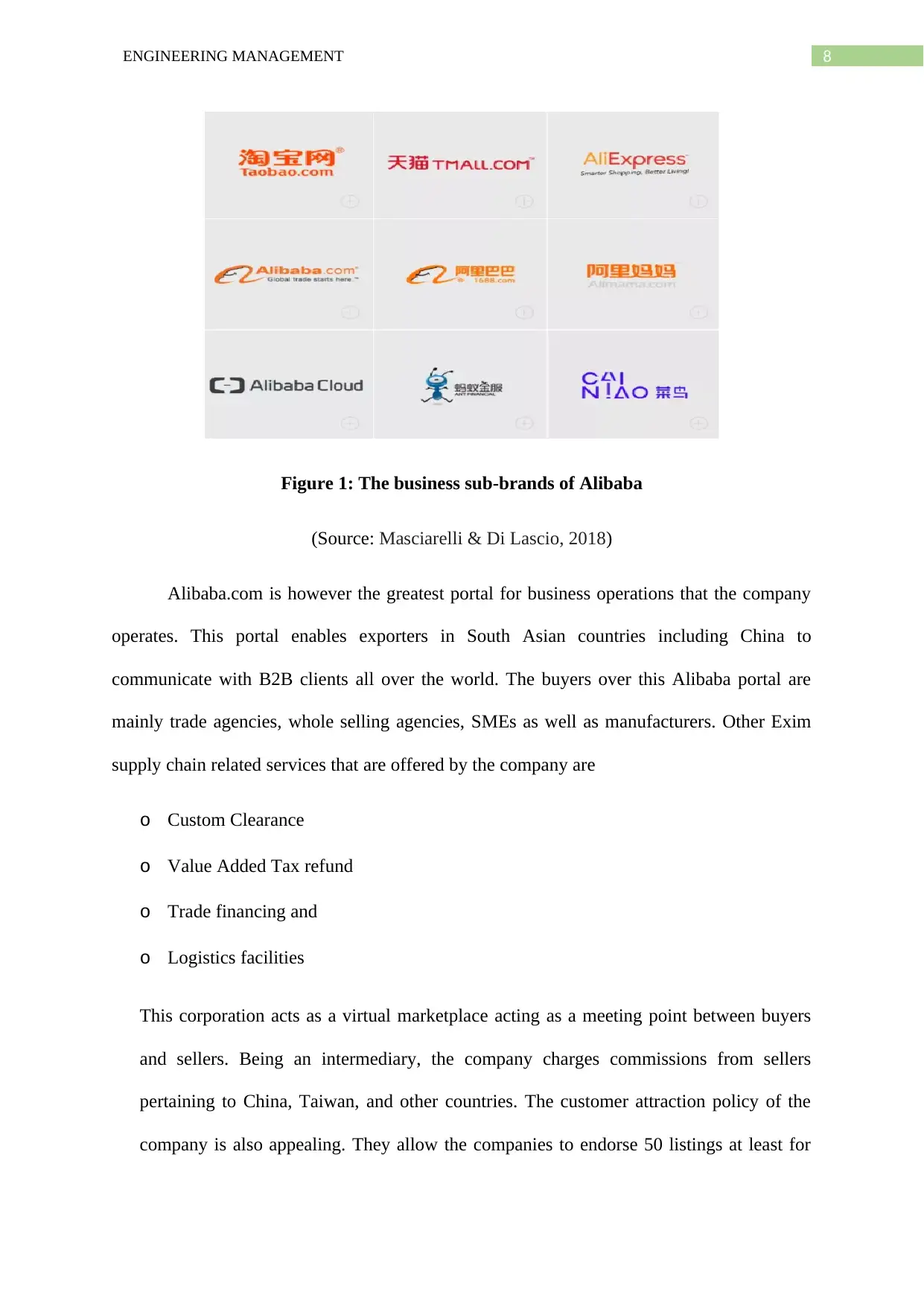
8ENGINEERING MANAGEMENT
Figure 1: The business sub-brands of Alibaba
(Source: Masciarelli & Di Lascio, 2018)
Alibaba.com is however the greatest portal for business operations that the company
operates. This portal enables exporters in South Asian countries including China to
communicate with B2B clients all over the world. The buyers over this Alibaba portal are
mainly trade agencies, whole selling agencies, SMEs as well as manufacturers. Other Exim
supply chain related services that are offered by the company are
o Custom Clearance
o Value Added Tax refund
o Trade financing and
o Logistics facilities
This corporation acts as a virtual marketplace acting as a meeting point between buyers
and sellers. Being an intermediary, the company charges commissions from sellers
pertaining to China, Taiwan, and other countries. The customer attraction policy of the
company is also appealing. They allow the companies to endorse 50 listings at least for
Figure 1: The business sub-brands of Alibaba
(Source: Masciarelli & Di Lascio, 2018)
Alibaba.com is however the greatest portal for business operations that the company
operates. This portal enables exporters in South Asian countries including China to
communicate with B2B clients all over the world. The buyers over this Alibaba portal are
mainly trade agencies, whole selling agencies, SMEs as well as manufacturers. Other Exim
supply chain related services that are offered by the company are
o Custom Clearance
o Value Added Tax refund
o Trade financing and
o Logistics facilities
This corporation acts as a virtual marketplace acting as a meeting point between buyers
and sellers. Being an intermediary, the company charges commissions from sellers
pertaining to China, Taiwan, and other countries. The customer attraction policy of the
company is also appealing. They allow the companies to endorse 50 listings at least for
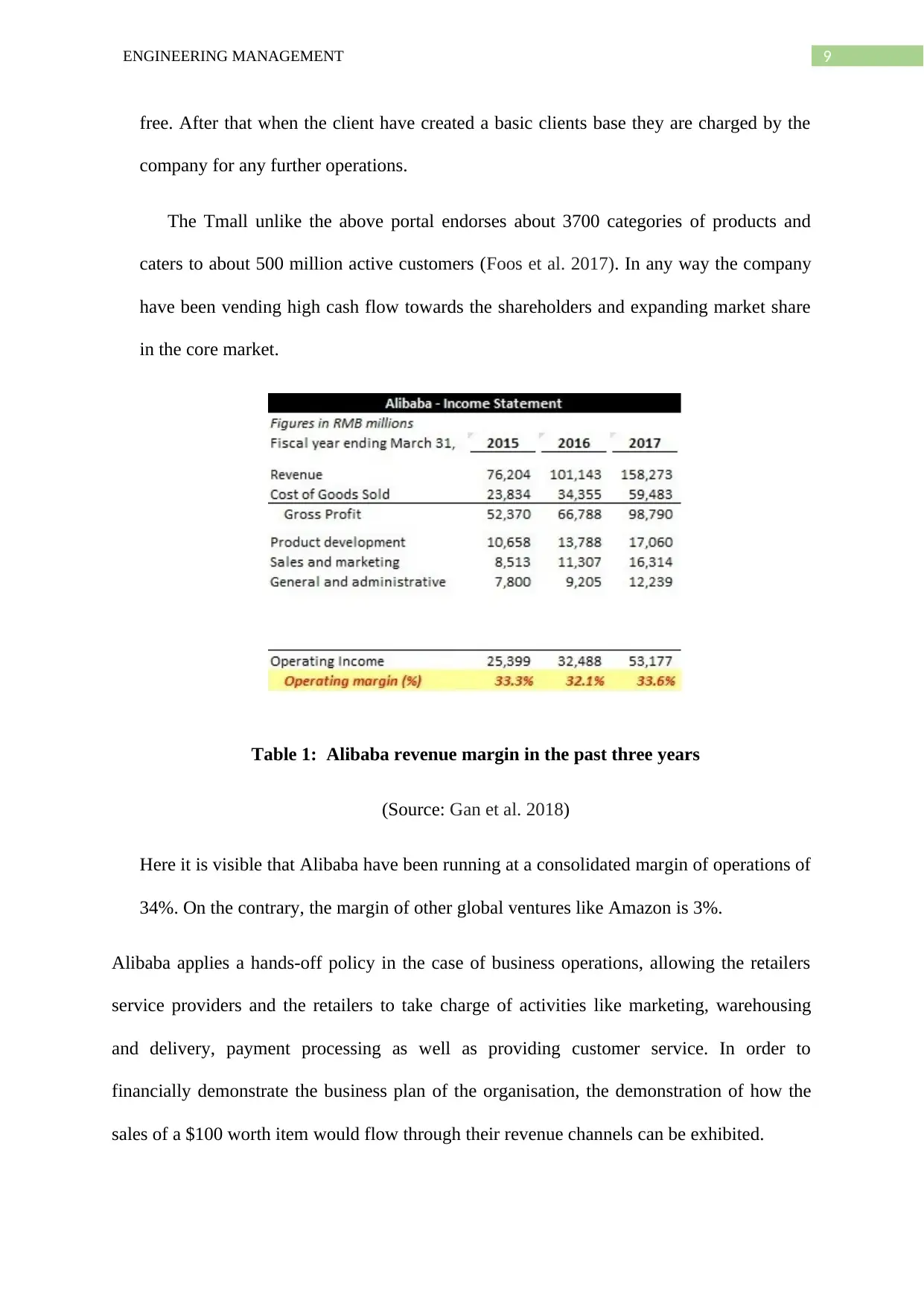
9ENGINEERING MANAGEMENT
free. After that when the client have created a basic clients base they are charged by the
company for any further operations.
The Tmall unlike the above portal endorses about 3700 categories of products and
caters to about 500 million active customers (Foos et al. 2017). In any way the company
have been vending high cash flow towards the shareholders and expanding market share
in the core market.
Table 1: Alibaba revenue margin in the past three years
(Source: Gan et al. 2018)
Here it is visible that Alibaba have been running at a consolidated margin of operations of
34%. On the contrary, the margin of other global ventures like Amazon is 3%.
Alibaba applies a hands-off policy in the case of business operations, allowing the retailers
service providers and the retailers to take charge of activities like marketing, warehousing
and delivery, payment processing as well as providing customer service. In order to
financially demonstrate the business plan of the organisation, the demonstration of how the
sales of a $100 worth item would flow through their revenue channels can be exhibited.
free. After that when the client have created a basic clients base they are charged by the
company for any further operations.
The Tmall unlike the above portal endorses about 3700 categories of products and
caters to about 500 million active customers (Foos et al. 2017). In any way the company
have been vending high cash flow towards the shareholders and expanding market share
in the core market.
Table 1: Alibaba revenue margin in the past three years
(Source: Gan et al. 2018)
Here it is visible that Alibaba have been running at a consolidated margin of operations of
34%. On the contrary, the margin of other global ventures like Amazon is 3%.
Alibaba applies a hands-off policy in the case of business operations, allowing the retailers
service providers and the retailers to take charge of activities like marketing, warehousing
and delivery, payment processing as well as providing customer service. In order to
financially demonstrate the business plan of the organisation, the demonstration of how the
sales of a $100 worth item would flow through their revenue channels can be exhibited.
⊘ This is a preview!⊘
Do you want full access?
Subscribe today to unlock all pages.

Trusted by 1+ million students worldwide
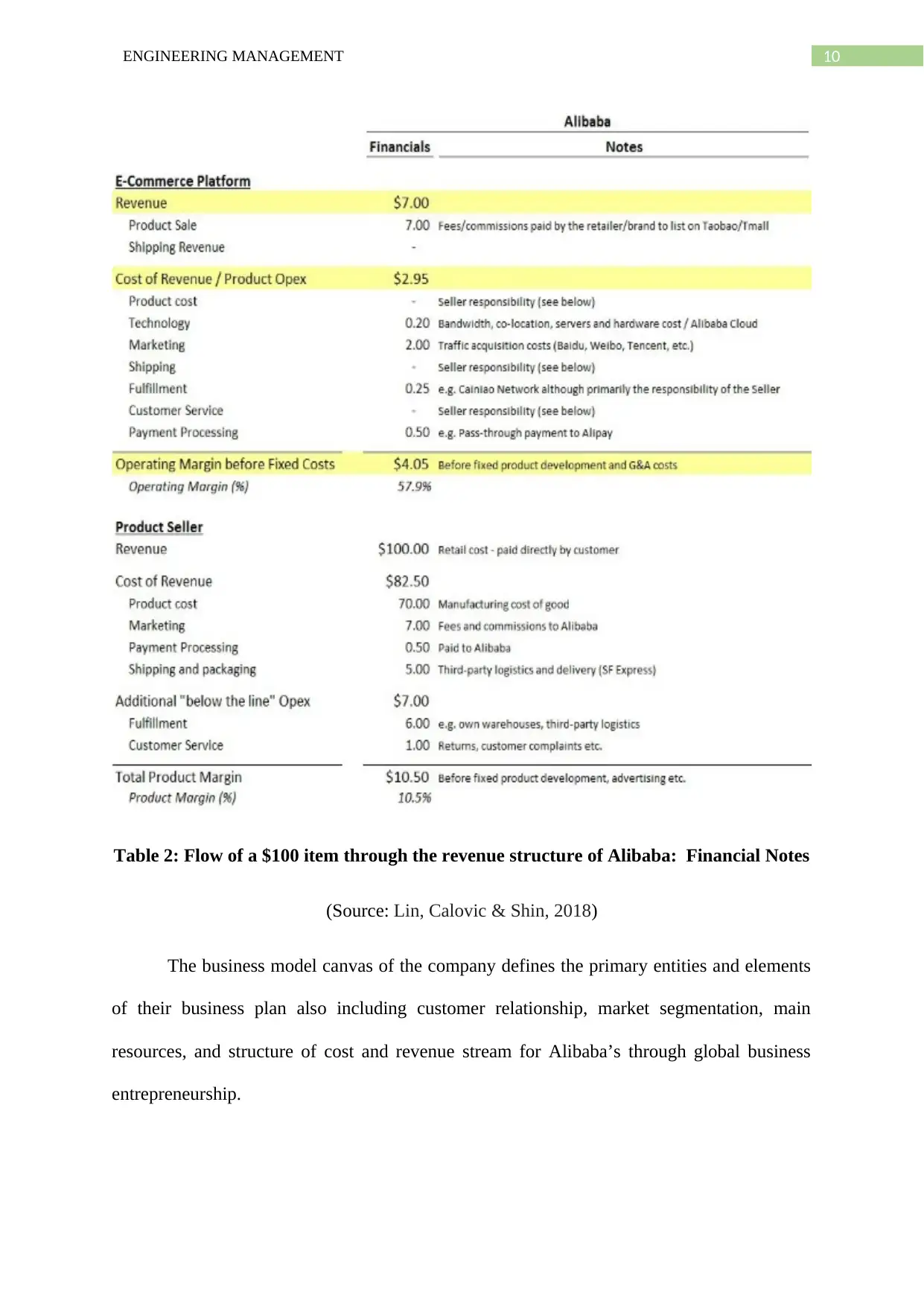
10ENGINEERING MANAGEMENT
Table 2: Flow of a $100 item through the revenue structure of Alibaba: Financial Notes
(Source: Lin, Calovic & Shin, 2018)
The business model canvas of the company defines the primary entities and elements
of their business plan also including customer relationship, market segmentation, main
resources, and structure of cost and revenue stream for Alibaba’s through global business
entrepreneurship.
Table 2: Flow of a $100 item through the revenue structure of Alibaba: Financial Notes
(Source: Lin, Calovic & Shin, 2018)
The business model canvas of the company defines the primary entities and elements
of their business plan also including customer relationship, market segmentation, main
resources, and structure of cost and revenue stream for Alibaba’s through global business
entrepreneurship.
Paraphrase This Document
Need a fresh take? Get an instant paraphrase of this document with our AI Paraphraser
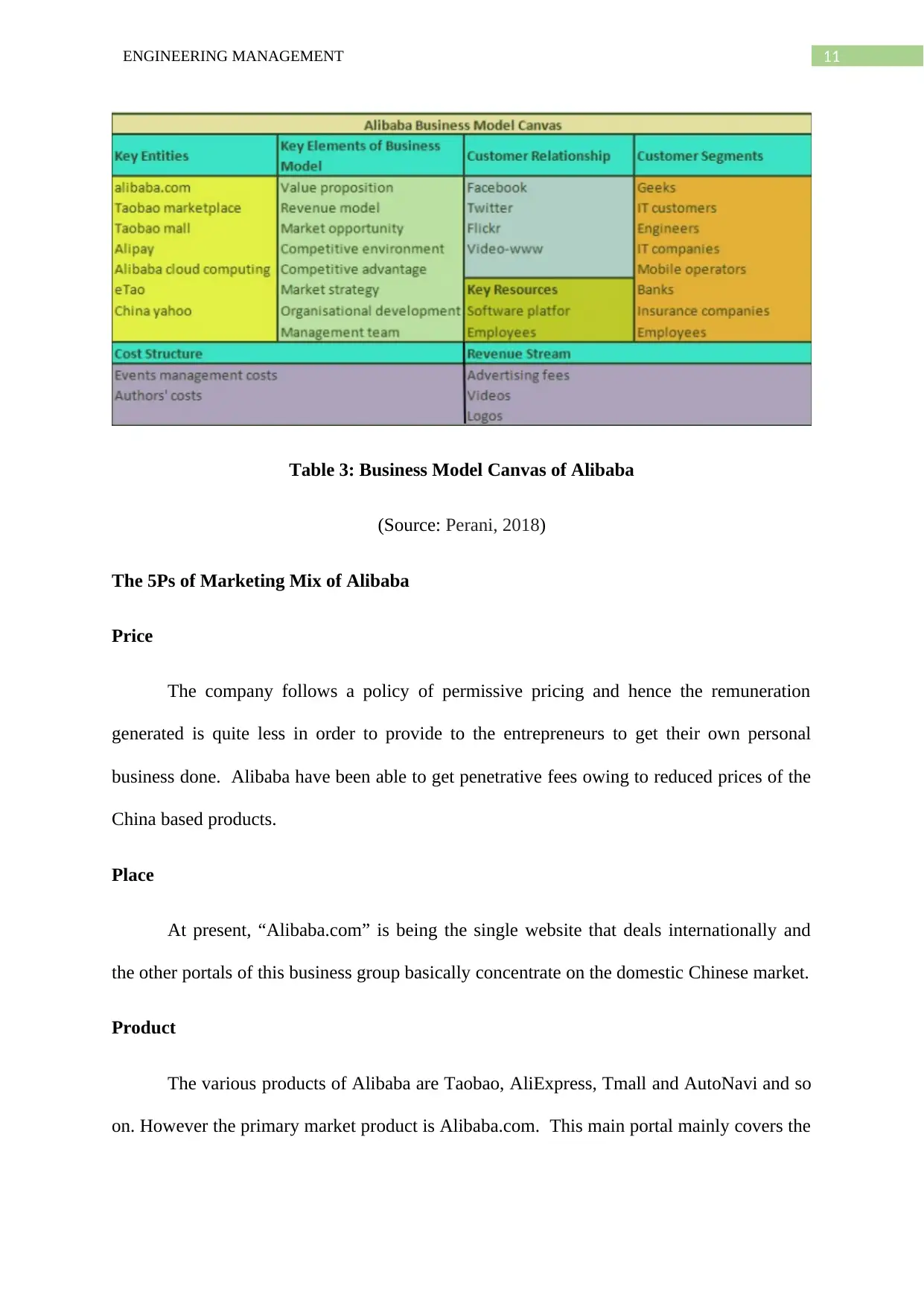
11ENGINEERING MANAGEMENT
Table 3: Business Model Canvas of Alibaba
(Source: Perani, 2018)
The 5Ps of Marketing Mix of Alibaba
Price
The company follows a policy of permissive pricing and hence the remuneration
generated is quite less in order to provide to the entrepreneurs to get their own personal
business done. Alibaba have been able to get penetrative fees owing to reduced prices of the
China based products.
Place
At present, “Alibaba.com” is being the single website that deals internationally and
the other portals of this business group basically concentrate on the domestic Chinese market.
Product
The various products of Alibaba are Taobao, AliExpress, Tmall and AutoNavi and so
on. However the primary market product is Alibaba.com. This main portal mainly covers the
Table 3: Business Model Canvas of Alibaba
(Source: Perani, 2018)
The 5Ps of Marketing Mix of Alibaba
Price
The company follows a policy of permissive pricing and hence the remuneration
generated is quite less in order to provide to the entrepreneurs to get their own personal
business done. Alibaba have been able to get penetrative fees owing to reduced prices of the
China based products.
Place
At present, “Alibaba.com” is being the single website that deals internationally and
the other portals of this business group basically concentrate on the domestic Chinese market.
Product
The various products of Alibaba are Taobao, AliExpress, Tmall and AutoNavi and so
on. However the primary market product is Alibaba.com. This main portal mainly covers the
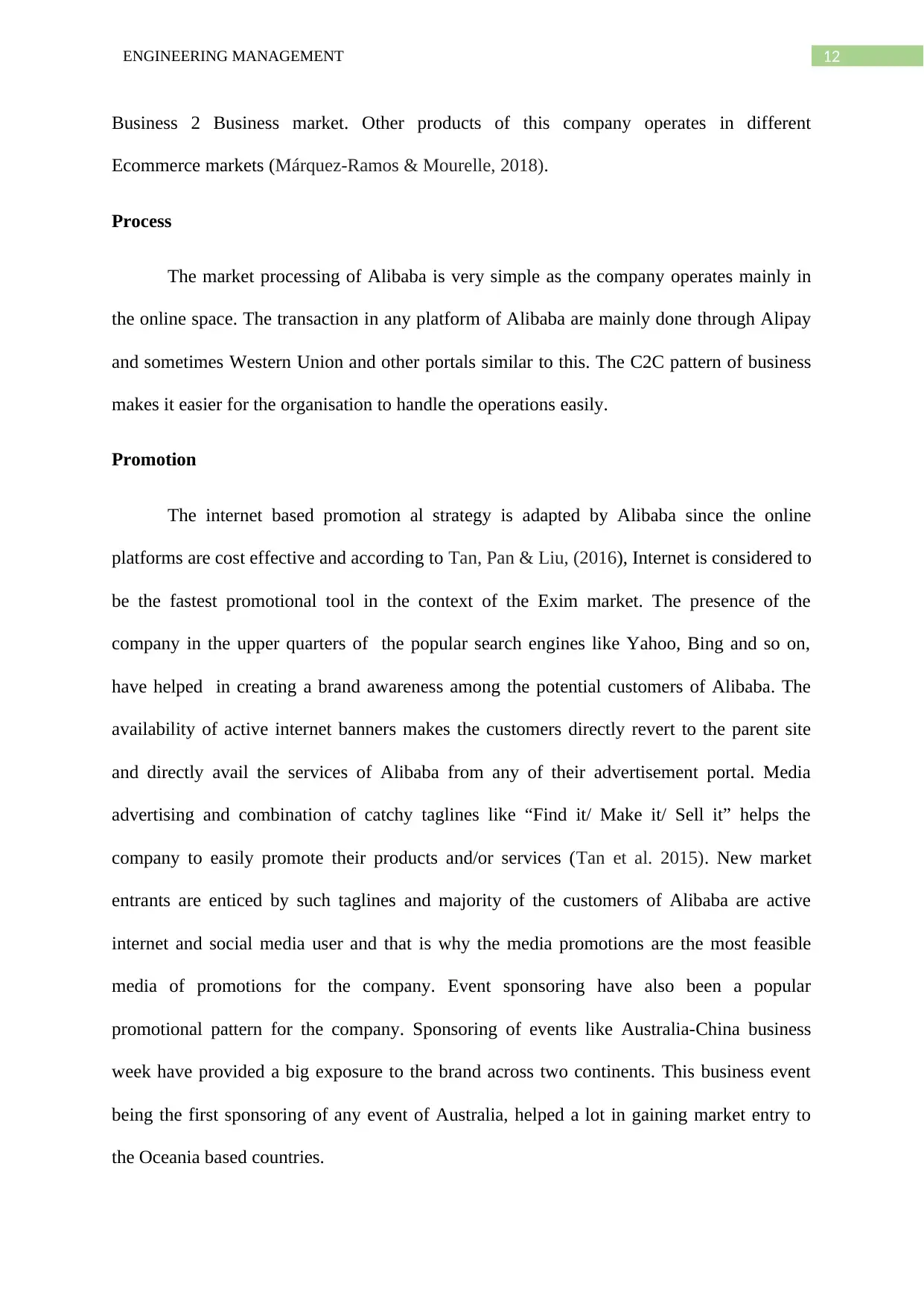
12ENGINEERING MANAGEMENT
Business 2 Business market. Other products of this company operates in different
Ecommerce markets (Márquez-Ramos & Mourelle, 2018).
Process
The market processing of Alibaba is very simple as the company operates mainly in
the online space. The transaction in any platform of Alibaba are mainly done through Alipay
and sometimes Western Union and other portals similar to this. The C2C pattern of business
makes it easier for the organisation to handle the operations easily.
Promotion
The internet based promotion al strategy is adapted by Alibaba since the online
platforms are cost effective and according to Tan, Pan & Liu, (2016), Internet is considered to
be the fastest promotional tool in the context of the Exim market. The presence of the
company in the upper quarters of the popular search engines like Yahoo, Bing and so on,
have helped in creating a brand awareness among the potential customers of Alibaba. The
availability of active internet banners makes the customers directly revert to the parent site
and directly avail the services of Alibaba from any of their advertisement portal. Media
advertising and combination of catchy taglines like “Find it/ Make it/ Sell it” helps the
company to easily promote their products and/or services (Tan et al. 2015). New market
entrants are enticed by such taglines and majority of the customers of Alibaba are active
internet and social media user and that is why the media promotions are the most feasible
media of promotions for the company. Event sponsoring have also been a popular
promotional pattern for the company. Sponsoring of events like Australia-China business
week have provided a big exposure to the brand across two continents. This business event
being the first sponsoring of any event of Australia, helped a lot in gaining market entry to
the Oceania based countries.
Business 2 Business market. Other products of this company operates in different
Ecommerce markets (Márquez-Ramos & Mourelle, 2018).
Process
The market processing of Alibaba is very simple as the company operates mainly in
the online space. The transaction in any platform of Alibaba are mainly done through Alipay
and sometimes Western Union and other portals similar to this. The C2C pattern of business
makes it easier for the organisation to handle the operations easily.
Promotion
The internet based promotion al strategy is adapted by Alibaba since the online
platforms are cost effective and according to Tan, Pan & Liu, (2016), Internet is considered to
be the fastest promotional tool in the context of the Exim market. The presence of the
company in the upper quarters of the popular search engines like Yahoo, Bing and so on,
have helped in creating a brand awareness among the potential customers of Alibaba. The
availability of active internet banners makes the customers directly revert to the parent site
and directly avail the services of Alibaba from any of their advertisement portal. Media
advertising and combination of catchy taglines like “Find it/ Make it/ Sell it” helps the
company to easily promote their products and/or services (Tan et al. 2015). New market
entrants are enticed by such taglines and majority of the customers of Alibaba are active
internet and social media user and that is why the media promotions are the most feasible
media of promotions for the company. Event sponsoring have also been a popular
promotional pattern for the company. Sponsoring of events like Australia-China business
week have provided a big exposure to the brand across two continents. This business event
being the first sponsoring of any event of Australia, helped a lot in gaining market entry to
the Oceania based countries.
⊘ This is a preview!⊘
Do you want full access?
Subscribe today to unlock all pages.

Trusted by 1+ million students worldwide
1 out of 24
Related Documents
Your All-in-One AI-Powered Toolkit for Academic Success.
+13062052269
info@desklib.com
Available 24*7 on WhatsApp / Email
![[object Object]](/_next/static/media/star-bottom.7253800d.svg)
Unlock your academic potential
Copyright © 2020–2025 A2Z Services. All Rights Reserved. Developed and managed by ZUCOL.





